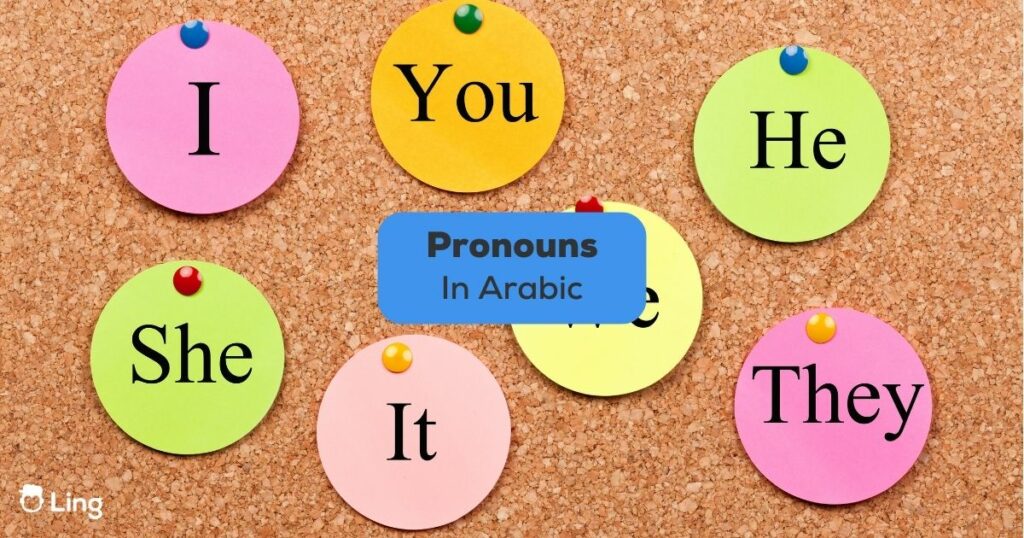The Arabic language has a rich history and complex grammar. And today we will focus on a significant part segment of Arabic grammar – Arabic pronouns. Pronouns are an important part of speech as they answer the question “who” in a sentence. This is the reason why pronouns is always included in the first lessons in any language-learning resource.
Yes, there are plenty of pronouns in Arabic, and they change according to gender, plurality, duality, etc. But don’t worry! In this article, we’ll explain the fundamentals of Arabic pronouns for you so that you can understand how they work without getting lost in the details.
Let’s take it from the beginning.
What Are Pronouns?
Pronouns are linguistic tools that replace nouns in sentences. They are essential for maintaining the flow and coherence of a conversation. Arabic pronouns can be in both word and suffix formats.
Why Learn Arabic Pronouns
Mastering Arabic pronouns is the first milestone of learning the language. They help you build effective communication, allowing you to express your ideas clearly. Also, you can express respect and politeness by using pronouns, which is highly valued in Arab culture.
Arabic pronouns come in various forms, each serving a unique purpose. Let’s explore some of the most common types.

1. Arabic Subject Pronouns
Subject pronouns, also known as personal pronouns, are used to replace people and objects in a sentence. Pronouns have different forms in Arabic such as singular, dual, and plural, expressing the numbers in Arabic. Let’s take a look at them one by one!
Singular Pronouns
Singular pronouns are used when referring to one person or object.
- I – أَنا (ana)
- you (masculine) – أَنتَ (anta)
- you (feminine) – أَنتِ (anti)
- he – هُوَ (huwa)
- she – هِيَ (hiya)
Dual Pronouns
Dual pronouns are employed when referring to two persons or objects.
- you two – أَنتُما (antuma)
- they two – هُما (humaa)
Plural Pronouns
Plural pronouns are used when referring to more than two persons or objects.
- we – نَحنُ (nahnu)
- you (plural masculine) – أنتم (antum)
- you (plural feminine) – أنتن (antun)
- they (plural masculine) – هم (hum)
- they (plural feminine) – هن (hun)
2. Demonstrative Pronouns
As you can guess from its name, the demonstrative pronoun is used to point out specific objects. It corresponds to the English words “this” and “that.” Naturally, the plural is equivalent to “these” and “those.”
Arabic is a language with genders, and therefore the demonstrative pronouns have different forms for male and female objects.
Demonstrative Pronouns For Near Objects
These pronouns are used when referring to objects that are close to the speaker. For example, “هذا” (hatha) means “this.”
- this (masculine) – هَذا (hatha)
- this (feminine) – هذه (hadihi)
- these (masculine/feminine) – هؤلاء (ha’ula)
Demonstrative Pronouns For Far Objects
Conversely, demonstrative pronouns for far objects are used when referring to items that are distant from the speaker. “ذلك” (thalika) is used to mean “that.”
- that (masculine) – ذلك (thalika)
- that (feminine) – تلك (tilka)
- those (masculine/feminine) – أولئك (ula’ika)

3. Arabic Possessive Pronouns
Possessive pronouns are used to express ownership. They express to whom an object or person belongs. The possessive pronouns in Arabic also come as suffixes. Similar to how we say “Tom’s book” in English, adding a suffix to the person who owns it. However, in Arabic, you should add the suffix to the thing being owned, not the person who owns it.
Singular Possessive Pronouns
Singular possessive pronouns are used to indicate ownership by one individual. Some examples include “كِتَابي” (kitabi) for “my book” and “بَيْتُهُ” (baytuhu) for “his house.”
- my – ي (-i)
- your (masculine) – ك (-ka)
- your (feminine) – ك (-ki)
- his – ه (-hu)
- her – ها (-ha)
Dual Possessive Pronouns
Dual possessive pronouns indicate ownership by two individuals. For example, “كتابكما” (kitabukuma) means “your two books” when two people own them.
- your (dual) -كما (-kuma)
- their (dual) -هما (-huma)
Plural Possessive Pronouns
Plural possessive pronouns denote ownership by multiple individuals. “بُيُوتُهُم” (buyutuhum) translates to “their houses.”
- our -نا (-na)
- your (plural masculine) -كم (-kum)
- your (plural feminine) -ـكن (-kunna)
- their (plural masculine) -هم (-hum)
- their (plural feminine) -هن (-hun)
4. Arabic Object Pronouns
You may think that Arabic verbs are difficult to understand, and I don’t blame you for that; they’re notorious. In Arabic, each pronoun comes as a suffix. When a verb has an object, you include it as a pronoun glued onto the end of the verb.
Singular Object Pronouns
- me -ي (-y)
- you (masculine) -كَ (-ka)
- you (feminine) -كِ (-ki)
- him -هُ (-hu)
- her -ه (-ha)
Dual Object Pronouns
- you (dual) -كُما (-kuma)
- them (dual) -هما (-huma)
Plural Object Pronouns
- us -نا (-nā)
- you (plural masculine) -ك (-kum)
- you (plural feminine) -ك (-kunna)
- them (plural masculine) -هم (-hum)
- them (plural feminine) -هن (-hunna)

Pronouns In Arabic Dialects
Modern Standard Arabic has a lot of rules that people must follow when they speak. However, dialects such as Egyptian Arabic, on the other hand, have more natural rules, so people can speak with no pressure.
But what does it have to do with pronouns? Well, it’s good news because you don’t have to memorize many rules!
For instance, the dual pronouns are gone. Colloquial Arabic doesn’t necessarily use the dual form anymore. You can use the plural pronouns instead. Plus, in colloquial Arabic, there are no plural forms to distinguish between masculine and feminine. You can use the masculine plural for speaking about both men and women.
FAQs About Arabic Pronouns
Let us take a look at some frequently asked questions related to pronouns in Arabic.
1. What Are The Most Common Personal Pronouns In Arabic Grammar?
The most common personal pronouns in Arabic include “أنا” (ana) for “I,” “هو” (huwa) for “he,” “هِيَ” (hiya) for “she,” and “أنت” (anta) for “you.”
2. How Do I Know When To Use Singular, Dual, Or Plural Pronouns In Arabic?
The choice between singular, dual, and plural pronouns in Arabic depends on the number of people or objects being referred to. Singular is for one, dual is for two, and plural is for more than two.
3. Why Are Demonstrative Pronouns Important In Arabic?
Demonstrative pronouns in Arabic help provide context and indicate the proximity of objects, making conversations clearer and more meaningful.
4. Can You Give An Example Of A Sentence Using Relative Pronouns In Arabic?
A sentence using a relative pronoun would be “الكتاب الذي أعطيتني” (al-kitab alladhi ae’taytani), which means “the book that you gave me.”
5. Where Can I Find Resources To Learn More About Arabic Pronouns?
You can find online language courses, textbooks, and language exchange partners to enhance your understanding of Arabic pronouns and the language as a whole. Additionally, you can explore language learning apps and websites for interactive learning experiences.
Start Learning Arabic With The Ling App!
If you want to learn Arabic from scratch, you should check out the Ling app!
What is the Ling app? It’s a language learning app designed to teach a foreign language from scratch to the advanced level. You can do various interactive exercises, such as practicing writing in Arabic script, learning new Arabic vocabulary in context, and using an AI chatbot to speak conversational Arabic. The Ling app offers you everything to enhance the four primary language skills.
Don’t forget to visit Ling’s Arabic blog for weekly articles covering topics related to this language and culture!
So, don’t wait any longer and head to the App Store or Play Store to download the Ling app today!




































































One Response
Please can you give 10 examples in each Arabic pronouns from first person to the third person?